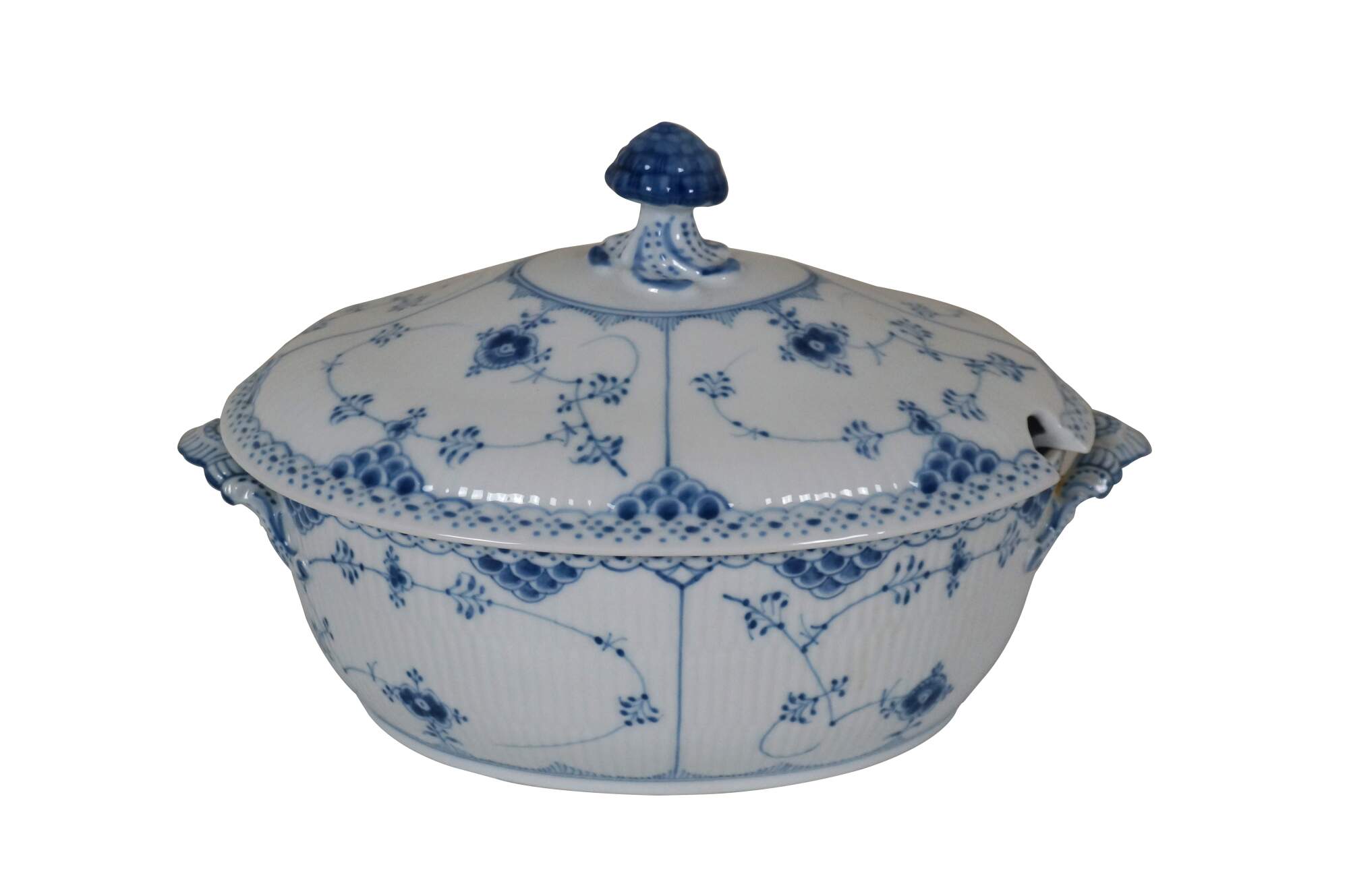
Shipping:
Free Shipping Included
Delivery:
Estimated 2-15 Business Days
Payments:
Credit Card, Check, Cash, PayPal, Apple Pay, Venmo
Returns:
30 Days 100% Money Back Guarantee, Buyer Pays Return Shipping
Description
Mid 20th century lidded porcelain soup turreen by Royal Copenhagen in the Musselmalet aka Blue Fluted / Half Lace pattern. Oval shape with ribbed sides and scallop shaped handles and mushroom shaped finial. Blue and white hand painted floral and lace design. Green backstamp dated 1960 (indicated by line under R of Denmark on backstamp), blue factory mark and artists initials XQ, green item number 1/595.
"Royal Copenhagen, officially the Royal Porcelain Factory, is a Danish manufacturer of porcelain products and was founded in Copenhagen in 1775 under the protection of Danish Dowager Queen Juliane Marie. It is recognized by its factory mark, the three wavy lines above each other, symbolizing Denmark's three water ways: Storebælt, Lillebælt and Øresund. The Royal Copenhagen manufactory's operations began in a converted post office in 1775. It was founded by chemist Frantz Heinrich Müller who was given a 50-year monopoly to create porcelain. Though royal patronage was not at first official, the first pieces manufactured were dining services for the royal family. When, in 1779, King Christian VII assumed financial responsibility, the manufactory was styled the Royal Porcelain Factory. The factory's pattern No. 1, still in production, is "Musselmalet", "mussel-painted", called "Blue Fluted" in English-speaking countries. In 1790, Royal Copenhagen was commissioned by the king to produce a "Flora Danica" dinner service, with gilded edges and botanical motifs copied from the ongoing illustrated Flora Danica. It was intended as a gift for Catherine the Great; Royal Copenhagen has produced hand-painted pieces of "Flora Danica" to this day. In 1851, Royal Copenhagen showed its production at The Great Exhibition in London. In 1868, as a result of royal companies' privatization, the Royal Porcelain Factory came into private hands, though the "Royal" designation was retained. The first female porcelain painter is employed and the craft of hand painting porcelain gradually becomes women’s work. In the mid-19th century the many large European porcelain companies generally stood aloof from artistic developments such as Japonisme, and the Arts and Crafts movement, concentrating on tableware, and often struggling to throw off what had become the deadening influence of Rococo and Neoclassical styles. The first major porcelain company to seriously change its styles was Royal Copenhagen, which made radical changes from 1883, when it was bought by Aluminia, an earthenware company. Arnold Krog, an architect under 30 with no practical experience of the industry, was made artistic director the next year, and rapidly shifted designs in the same directions art pottery was exploring, commissioning many painters to design for the factory. Krog’s first step in breathing new life into the world of royal Danish porcelain is to further develop the technique for painting under the glaze, making it possible to depict landscapes and naturalistic decorations on the porcelain. Shortly after Aluminia's acquisition, Royal Copenhagen production was moved to a modern factory building at Aluminia's site in Frederiksberg, on the outskirts of Copenhagen. At the Exposition Universelle (1889) in Paris, Royal Copenhagen won the Grand Prix, giving it international exposure. In recent years, Royal Copenhagen acquired Georg Jensen in 1972, incorporated with Holmegaard Glass Factory in 1985, and finally Bing & Grøndahl in 1987. Royal Copenhagen was a part of a group of Scandinavian companies, Royal Scandinavia, together with Georg Jensen, and was owned by a Danish private equity fund, Axcel. Following Axcel's acquisition of Royal Scandinavia, Holmegaard Glasværk was sold in a MBO, and a controlling interest in the Swedish glass works Orrefors Kosta Boda was sold to New Wave Group. In December 2012, Axcel sold Royal Copenhagen to the Finnish listed company Fiskars, which was founded in 1649. The company now produces its products in Thailand." (Source: Wikipedia / Royal Copenhagen)
Condition
Good Overall - Gentle wear, no label
Dimensions
12.5" x 8.5" x 8" (Width x Depth x Height)